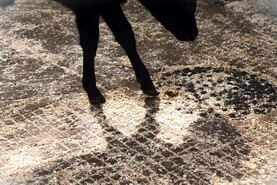The majority of calves that are reared on farms will be reared in sheds that have not been specifically designed with calf rearing in mind.
This, along with the vast array of weather conditions experienced throughout the rearing phase, mean that no shed is completely suited to calf rearing.
Microclimate
Microclimates are becoming increasingly popular in calf sheds across the country. This involves creating a canopy over the calves’ heads, typically at the back of pens, to eliminate drafts and keep the temperature of the lying area more consistent.
Construction can be as simple as a few sheets of 8×4 plywood.

An example of a calf microclimate.
Microclimates should not be too deep, as this can affect the success of the ventilation. What we do not want to do is stop the flow of air in the shed or stop stale air from being removed from the calves’ environment.
A calf’s bed needs to be dry at all times
Any farmer who has one installed in the shed will tell you that, without fail, calves will constantly choose to lie in under the microclimate.
This has been particularly true in the recent windy wet weather, where some pens may have been breezy or wet had the microclimate not been in place.
A calf’s bed needs to be dry at all times to ensure they are not burning energy to maintain their core temperature.
The best way to check this is to kneel down in the pen. If you have wet knees when you stand up, the bedding is insufficient.
The microclimate also keeps the temperature of the lying environment more consistent.
If calves are cold, they will require more energy just to maintain their body temperature.
Another way to minimise the loss of energy due to colder periods of weather is to feed an extra 50g of milk replacer per calf for every 5°C drop below 15°C.
The majority of calves that are reared on farms will be reared in sheds that have not been specifically designed with calf rearing in mind.
This, along with the vast array of weather conditions experienced throughout the rearing phase, mean that no shed is completely suited to calf rearing.
Microclimate
Microclimates are becoming increasingly popular in calf sheds across the country. This involves creating a canopy over the calves’ heads, typically at the back of pens, to eliminate drafts and keep the temperature of the lying area more consistent.
Construction can be as simple as a few sheets of 8×4 plywood.

An example of a calf microclimate.
Microclimates should not be too deep, as this can affect the success of the ventilation. What we do not want to do is stop the flow of air in the shed or stop stale air from being removed from the calves’ environment.
A calf’s bed needs to be dry at all times
Any farmer who has one installed in the shed will tell you that, without fail, calves will constantly choose to lie in under the microclimate.
This has been particularly true in the recent windy wet weather, where some pens may have been breezy or wet had the microclimate not been in place.
A calf’s bed needs to be dry at all times to ensure they are not burning energy to maintain their core temperature.
The best way to check this is to kneel down in the pen. If you have wet knees when you stand up, the bedding is insufficient.
The microclimate also keeps the temperature of the lying environment more consistent.
If calves are cold, they will require more energy just to maintain their body temperature.
Another way to minimise the loss of energy due to colder periods of weather is to feed an extra 50g of milk replacer per calf for every 5°C drop below 15°C.







 This is a subscriber-only article
This is a subscriber-only article











SHARING OPTIONS: